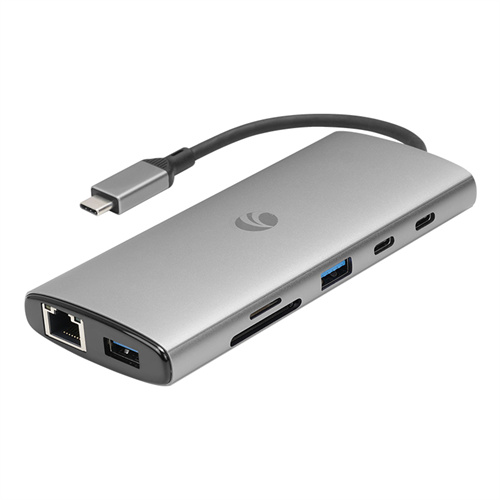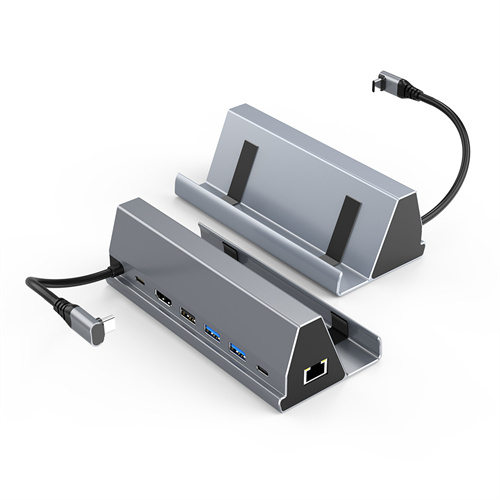With the advancement of technology and the change in people's aesthetics, the thinness of laptops on the market has become an irreversible mainstream trend.
While becoming more and more simplified, the external expansion capabilities of the laptop itself have also been sacrificed: various interfaces such as USB, HDMI, LAN, and VGA have been canceled.
Because the size of these interfaces will also limit the thickness of the laptop, some laptops even only retain the USB-C interface.
What if the user needs other external devices? At this time, you need a docking station and a hub to help you!
While they might seem similar, they serve different purposes and cater to different user needs. This article explores the differences between USB-C hubs and docking stations, helping you make an informed choice.
What is a USB C Hub?
A USB-C hub is a compact device designed to expand the connectivity options of a single USB-C port. It acts as a splitter, allowing users to connect multiple peripherals simultaneously.
Primary Function: The main function of a USB-C hub is to increase the number of USB ports available. This is particularly useful for devices like laptops that have limited ports.
Typical Features: Common features of USB-C hubs include additional USB-A and USB-C ports, SD and microSD card readers, and HDMI outputs for video.
Use Cases: USB-C hubs are ideal for users who need to connect several peripherals, such as a mouse, keyboard, and external storage, without occupying multiple ports on their device.

What is a USB C Docking Station?
A USB-C docking station is a more robust solution designed for stationary setups, often used in office environments. It provides a single connection point for multiple devices, streamlining the workspace.
Primary Function: Docking stations generally have power interfaces to provide more stable and higher power output for connected peripherals to ensure the normal operation of connected devices. The purpose of using a docking station is to turn a portable laptop into a desktop workstation.
Typical Features: Docking stations typically include multiple display outputs (HDMI, DisplayPort), Ethernet ports for wired internet, audio jacks, and high-wattage power delivery to charge devices.
Use Cases: Docking stations are ideal for professionals who need a powerful and versatile connection solution, often using multiple monitors and peripherals.

USB C Hub vs. USB C Docking Station
Portability: USB-C hubs are generally small and lightweight, making them easy to carry around. Docking stations are larger and more suited to a fixed location.
Power Delivery: Hubs usually offer limited power delivery, sufficient for small devices. Docking stations, on the other hand, can provide significant power, enough to charge laptops and other high-power devices.
Number of Ports: Hubs typically have fewer ports compared to docking stations. Docking stations offer a wide array of ports, including multiple display outputs and Ethernet.
Performance: Docking stations often provide better performance, supporting multiple high-resolution displays and faster data transfer speeds. Hubs are sufficient for basic peripheral connectivity.
Use Cases: Hubs are ideal for users who need a portable solution for connecting peripherals on the go. Docking stations are best for those who require a full desktop setup with multiple monitors and extensive connectivity options.
Cost: Generally, USB-C hubs are more affordable than docking stations. The advanced features and capabilities of docking stations come at a higher price point.
Best Brands for USB C Hubs and USB C Docking Stations
USB C Hubs:
VCOM: VCOM offers a range of reliable and affordable USB-C hubs. Their hubs provide essential connectivity options like USB-A ports, HDMI output, and SD card readers. VCOM products are known for their durability and good performance.
Anker: Anker is well-regarded for its high-quality USB-C hubs. Their hubs often include multiple USB-A and USB-C ports, HDMI, and Ethernet, making them versatile for various needs. Anker hubs are praised for their robust build and reliability.
Satechi: Satechi hubs are sleek and stylish, often matching the aesthetics of modern laptops like MacBooks. They offer a range of connectivity options, including USB-A, HDMI, and SD card slots. Satechi is known for combining functionality with design.
USB C Docking Stations:
VCOM: VCOM also produces excellent docking stations. Their products feature multiple display outputs, Ethernet ports, audio jacks, and high power delivery. VCOM docking stations are praised for their performance in professional settings.
Dell: Dell docking stations are designed with business users in mind. They offer comprehensive connectivity, including multiple monitor support, Ethernet, and robust power delivery. Dell is known for its reliable and high-performance docking stations.
CalDigit: CalDigit docking stations are popular for their premium build quality and extensive port options. They support multiple high-resolution displays, fast data transfer rates, and power delivery. CalDigit products are ideal for power users who need top-notch performance.
Conclusion
Docking stations and hubs are both good helpers for laptop expansion devices. When purchasing, just pay attention to whether they meet your needs and psychological price range.
If you are interested in computer peripherals, just follow VCOM! Check out our Products here!
Tag:USB C HUB,USB C DOCKING




